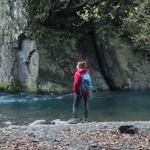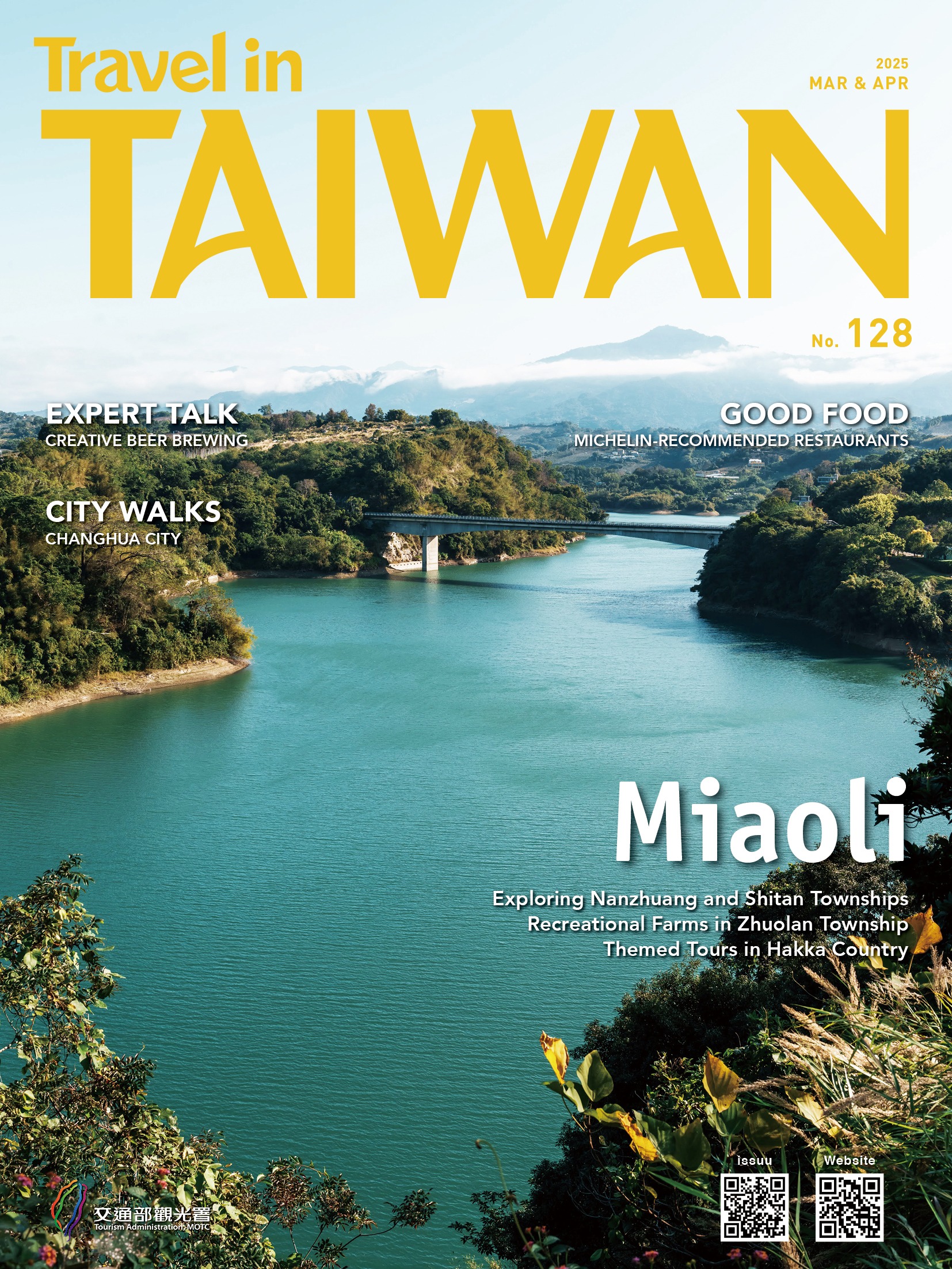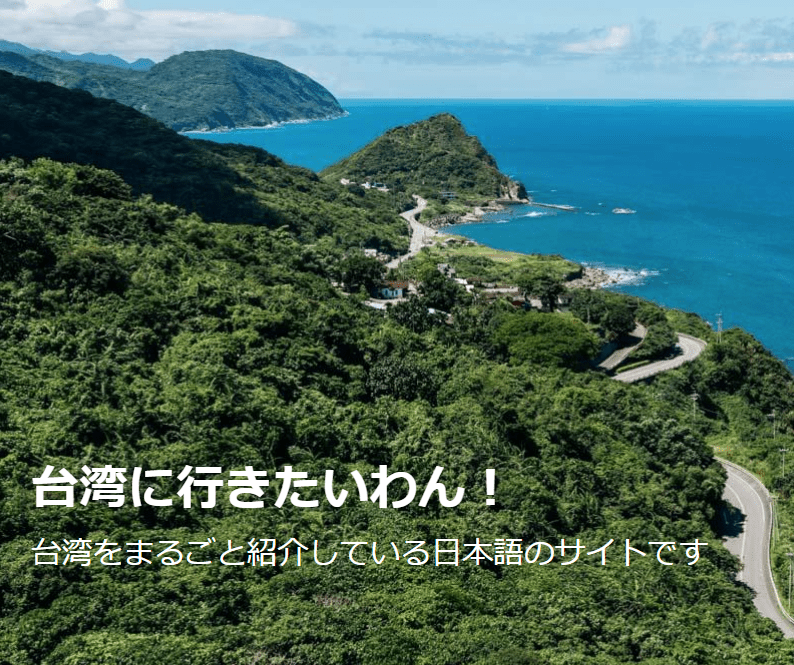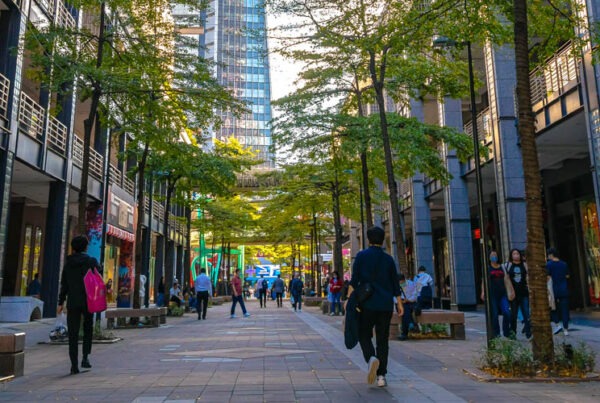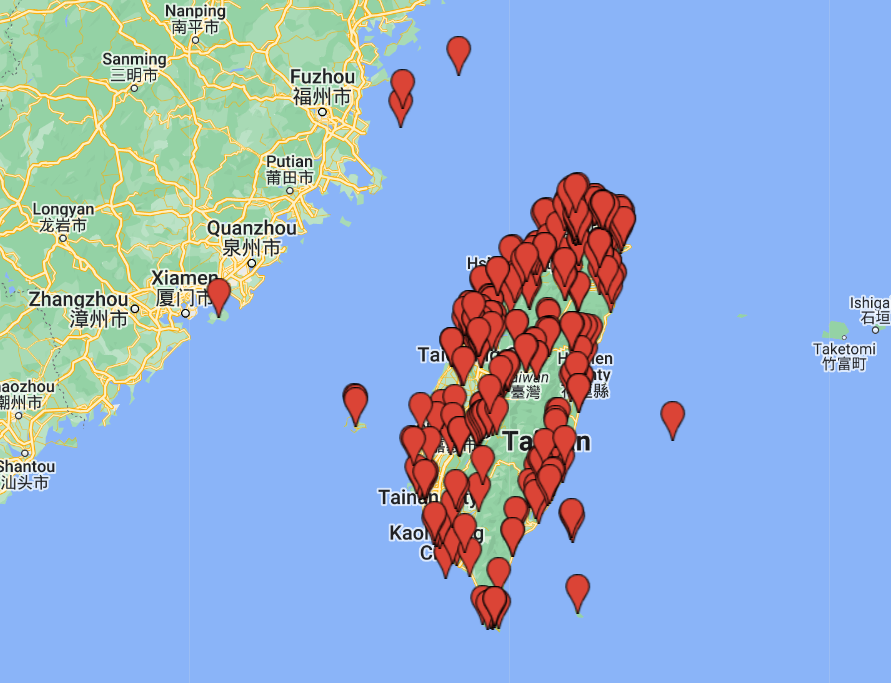Walks, Wildlife, and a Whistle-stop Tour of Taichung’s Former Logging Industry
TEXT | AMI BARNES
PHOTOS | RAY CHANG
Remote and rugged, Taichung’s Heping District stretches deep into Taiwan’s mountainous interior. Travelers who wend their way up its winding backroads will soon find themselves dwarfed by seemingly endless forests. Up here, the views are fresh, the air is tree-scented, and a wild avian chorus provides the music — in short, it’s the perfect place for quiet communion with nature.
The border between the Taichung City districts of Dongshi and Heping delineates two areas of distinct character. Genteel Dongshi offers mile after mile of easy bike trails and Hakka settlements with many temples, fruit farms, and filling food. Higher-elevation Heping, meanwhile, is wilder. Up here, maples and cherry trees mark the passage of time, and as you ascend, the hiking trails quickly begin to outnumber the roads – and this also happens to be one of Taiwan’s premier bird-spotting locations. The thread marrying these two contiguous but contrasting districts is the vestigial presence of the region’s long-defunct logging industry. Over the following pages, you will find more than enough tangentially logging-related attractions to fill a varied two- or three-day excursion.
Dasyueshan National Forest Recreation Area
If you open up a map and trace a finger up the winding route of Dasyueshan/Daxueshan* Forest Road, you’ll see that it quickly leaves the urban parts of Dongshi behind, then passes through a few agricultural areas before diving headlong into the unbroken mass of green stretching along Taiwan’s mountainous north-south spine. Replicating this finger-walking journey by car or bus brings an added dimension. As your vehicle climbs, you’ll pass orchards with oranges and peaches – the slopes ensnared in a messy spiderweb of trellises and waterpipes. Crack open a window and you’ll notice the atmosphere begin to shift. First, the mix of birdsong changes, then gradually cooler air begins to slip through – its earthy-sweet coldness a blessing for anyone prone to motion sickness. By the time you arrive at the entrance to Dasyueshan National Forest Recreation Area, you’ll find yourself surrounded by dense forest and greeted by temperatures a full ten degrees Celsius lower than the urban areas you’ve just left behind.

This part of Taiwan was first inhabited by members of the Atayal indigenous people. Indeed, a significant proportion of today’s Heping District’s inhabitants – a little over a third – classify themselves as Atayal. To their ancestors, the area around Mt. Dasyue was known as “Babo Rinisan” or “The Mountain of Tearful Farewells,” recalling the southern sub-tribes’ tradition of escorting young women on their way to marry into the northern sub-tribes. Upon reaching the point where the two groups’ hunting grounds met, they would say their goodbyes to the brides-to-be and head home heavy-hearted. The mountain’s current official name, although inarguably less poignant, also reveals a snippet of Taiwan’s history; it was bestowed by the Japanese during their colonial rule of Taiwan (1895-1945), who decided the grasslands up near the summit of Mt. Dasyue resembled the landscape of Hokkaido’s Daisetsuzan Volcano Group**.
*Tongyong Pinyin romanization (“Dasyueshan”) is used for place names within the forest recreation area; elsewhere, you might see Hanyu Pinyin (“Daxueshan”/“Mt. Daxue”).
**The Kanji characters for Daisetsuzan are identical to the Chinese characters for Dasyueshan.
Despite leaving their toponymic mark on the map, the Japanese left the forests here relatively untouched – they had enough on their hands with the extensive logging operations in other areas like Alishan and Taipingshan. Instead, it was the post-war Kuomintang (Nationalist) government that designated Dasyueshan a forestry operation zone and – with assistance from the U.S. – set about establishing Taiwan’s first industrialized lumber extraction facility. At its peak, Dasyueshan was the largest timber producer in East Asia, but gradually production declined, and after logging ceased in 1988 management was turned over to the Forestry Bureau (www.forest.gov.tw, renamed Forestry and Nature Conservation Agency in 2023), which transitioned the area into a recreation and conservation zone. Today, this national forest recreation area is one of 19 scattered across Taiwan’s main island, its seasonal beauty and biodiversity abundance drawing visitors from near and far.
After entering the area, the Dasyueshan Visitor Center presents the logical jumping-off point for your adventures. Located an 8km drive from the forest recreation area’s ticket gate, this is where you can find maps outlining the park’s trail network, get advice from knowledgeable staff, fill your water bottle, pick up leaflets introducing the local wildlife, and check out which species have been spotted where on an interactive sightings chart. The center also has displays detailing the park’s flora, fauna, and history, as well as a little glimpse into the work undertaken by park rangers. And if you scale the steps leading to the exterior fourth-floor viewing platform, you might be able to watch the sea of clouds lapping at the lower elevation slopes as the sun sets behind Mt. Yuanzuei.
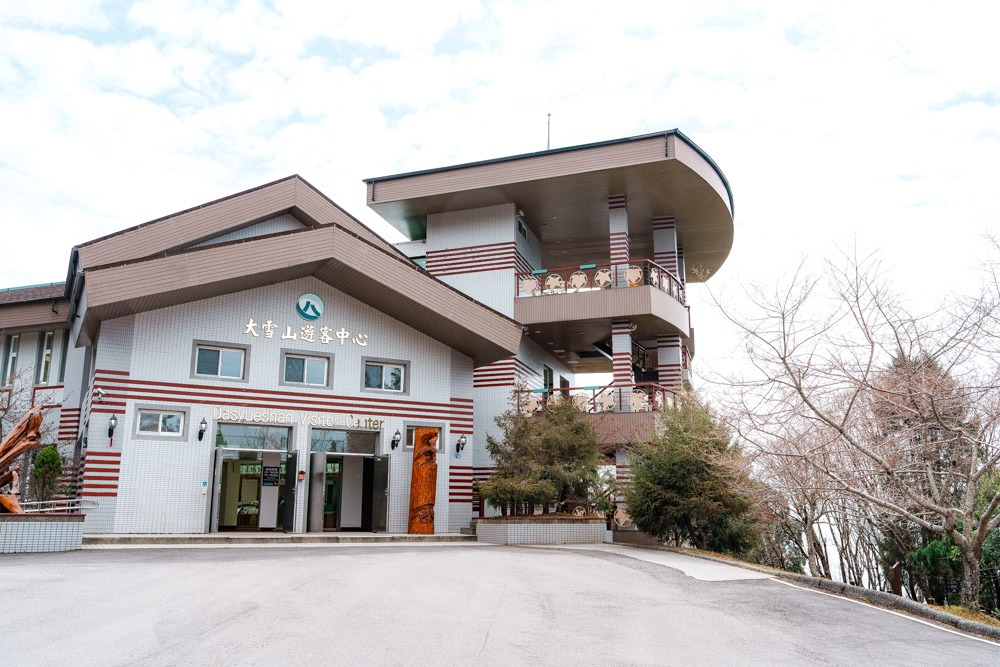



Hiking the Trails
One primary attraction for visiting Dasyueshan is the area’s network of hiking trails. Even if you stay a couple of nights, you would struggle to explore all of them in satisfying depth. The longest walk within the confines of the park is the 9.2km Shaolai-Siaosyueshan National Trail (part of an even longer national trail that connects to the dramatically exposed peak of Mt. Yuanzuei). This route kicks off close to the ticket gate and climbs through a dreamy forest populated by huge hemlocks and proud pines. On clear days, sunlight filters through the upper canopy, casting the forest floor in dappled shade and warming the pine duff so it emits a sweet woody scent, while on days when the clouds hang low, the trail scenery is transformed into something out of a fairytale. The trail climbs to pass first Mt. Chuansing and then Mt. Anma before eventually descending to the Siaosyueshan Travel Information Station, where you can top up your water bottle and use the bathroom facilities before hopping on a bus back down (final departure 4:45 pm daily).
If you’re looking for a similar forest bathing experience with a slightly lower kilometer count, the Skidway Trail is a great choice. It starts at the Dasyueshan Visitor Center and comes in at just under 4km, plus an additional 2.7km to loop back along the road. As you climb, look out for the remains of the logging-era electricity poles – their skeletal frames standing at wonky angles – then, as the trail levels off, you’ll pass a demonstration skidway installation showing how workers in the past transported felled logs using nothing but ingenuity and brawn. The remainder of the walk is either flat or downhill and leads you past some magnificent giant trees that somehow escaped the rush to plunder the forest’s treasures.







Taking the road that runs between the Dasyueshan Visitor Center and the Siaosyueshan Travel Information Station, you will pass the trailhead for the Yakou Scenic Trail. This short out-and-back walk is just 1.5km and can easily be completed in under an hour, but don’t let its diminutive stats put you off – if you’ve got a hankering for big views, this trail is one you can’t miss. The walk climbs to a three-tier lookout with panoramic prospects over Mt. Dasyue to the east, sweeping south to take in Mt. Hehuan, and over several of the Guguan Seven Heroes, before being cut off by the trees just west of Mt. Shaolai. If you’re staying the night in the park and there’s a clear morning forecast, this is also an ideal spot to catch the sunrise.



Heading even further along the road, there are two more trails to explore close to the Siaosyueshan Tourist Information Station. The Heavenly Pond Trail brings you to a small alpine lake tucked into a pine-ensconced depression. A path encircles the lake, and as you traverse it you can watch the shifting reflections of sky, clouds, and the Rueisyue Pavilion dance across the surface of the water. The lake is accessed either via a gently sloping path leading uphill from the information station or via a much steeper flight of stairs from the parking lot for the final route detailed here, the Syueshan Sacred Tree Trail. This last walk is an almost entirely step-free route following an old forestry track that descends for 1.5km to visit a millennial Formosan red cypress tree, or – to be precise – a cluster of red cypresses that have grown locked together in a process called inosculation.






Wildlife Spotting
The second main draw for travelers coming to Dasyueshan National Forest Recreation Area is its abundant and easily sighted wildlife. In particular, the forests up here are blessed with a turbo-charged diversity of bird species – so much so that Dasyueshan Forest Road has become a hotspot for birders. The forest recreation area even hosts an annual contest in which teams of bird spotters race to photograph or record the greatest number of species in a 24hr period.
Of the 674 bird species that can be found in Taiwan, 225 have been sighted in the Dasyueshan area, including 28 of the nation’s 32 endemic species. You barely need to break a sweat to get started on your bird-spotting adventures – it’s common to see bird lovers hunkered down on camp chairs just beside the road, long lenses at the ready. Even we non-pros ended up with a healthy haul of sightings on our recent Travel in Taiwan visit to the area. We were barely out of our car at the Yakou Scenic Trail car park when we spotted the first of many white-whiskered laughing thrushes. On the short Heavenly Pond Trail, I saw a flock of Taiwan fulvettas, a couple of comically angry-looking black-throated bushtits, and a Eurasian nutcracker. The Syueshan Sacred Tree Trail added yellow-bellied bush warblers and coal tits to my lifer list, and from the visitor center’s viewing platform, I watched a flurry of grey-headed bullfinches chatter in the treetops.


To get the most out of your visit to Dasyueshan National Forest Recreation Area, it’s definitely worth staying a night there. Not only does this allow you to maximize time spent exploring the trails, but it also means you get to experience the different faces the park presents at different times of day. You can enjoy the morning apricity as the sun chases away the chill, watch the afternoon clouds roll in and cut the park off from the world outside, and then stargaze under the clear night sky. Rooms in the park’s rustic accommodation facilities are simple but cozy and can be booked by email ([email protected]; prices start at NT$2,400 for a double room including dinner and breakfast), but you’ll need to make sure you bring your own towel and toiletries.
One especially neat perk of staying the night is that it means you can meet the park’s nocturnal wildlife – often just meters from the front door of your accommodation. During our visit, we tagged along on a night tour conducted in Chinese by the knowledgeable and talented guide Zhuang Yi (the deputy manager of the forest recreation area). Ostensibly, we were out there hunting for red and white giant flying squirrels, but as we embarked upon a short wander around the trails close to the visitor center, we were treated to Zhuang’s impressive repertoire of animal calls – birds, deer, monkeys, and frogs were all replicated with uncanny accuracy – interspersed with a slew of groan-worthy dad jokes. Even if we hadn’t spotted any of the elusive nocturnal gliders (we saw several, as well as a serow and a couple of muntjacs), I’m pretty sure everyone would have walked away from the tour feeling greatly enriched.


The tours are run intermittently, mostly during school holidays, so it’s worth calling ahead to find out if one will be held during your visit. Yet even if there aren’t any organized activities, it’s still well worth taking a nighttime walk – all the creatures we spotted were seen from the paved and lit trails around the restaurant, staff dormitories, and guest accommodation buildings.
Dongshi District
The first sizable town you arrive at as you descend from Dasyueshan’s elevated forests is Dongshi, a Hakka-majority settlement beside the Dajia River. And – given that Dasyueshan is connected to the town with a purpose-built logging road – it should come as no surprise that Dongshi was once an important wood-processing hub. The timber industry is long gone, but the site previously occupied by the sawmill is these days enjoying a second life as Dongshi Forestry Cultural Park, and visiting it provides context to the decapitated stumps and logging leftovers littering the trails up in the mountains.

Opened in 1964, the mill was modeled on Seattle’s lumberyards and managed by the Tashushan Forestry Corporation – a government-backed enterprise that aimed to revolutionize Taiwan’s logging industry with its integrated forest-to-final-user facility. Among the site’s most enduring claims to fame is that in 1968 – when the newly introduced nine-year compulsory education policy spiked demand for school furniture – the company promptly churned out half a million chair-and-desk sets, meaning that the posteriors of most likely all Taiwanese of a certain generation have graced a Tashushan chair. However, the company’s attempts to introduce American logging and lumber-processing techniques were ultimately doomed to failure, and in 1973, a combination of mismanagement, declining revenue, and problems with ill-suited equipment led to the plant’s closure.
Some of the mill structures were lost to fire in 2006, but those that survived have been lightly spruced up and turned into a scenic, free-to-visit cultural park. The mill’s lumber pond – where logs would have been stored before being processed – is the park’s central feature, and as you wander the shady trails, you’ll encounter impressive wooden sculptures, all crafted using scraps left behind when the sawmills closed.


Taking an anticlockwise walk around the pool, you’ll come across a collection of preserved mill facilities. An A-frame building sits at the water’s edge, its sloping wooden sides forming pleasing reflections for anyone observing from the far side of the pond. This was where waste wood and sawdust were siphoned via a conveyor belt before being used to power the boiler. Nearby is the chip bin – a stilt-legged storage structure for holding paper-production-bound wood chips – and several hulking steel contraptions capable of transporting and processing massive logs. All are introduced with helpfully bilingual signage.


The newest addition to the park’s attractions is an exhibition space occupying the former repair factory. This high-ceilinged hangar – which, at the time of our visit had only been open a month – is filled with displays documenting the rise and fall of Dasyueshan’s logging industry. Features like the old inspection pits and electricity boxes have been left in situ, and the exhibits include plenty of logging and mill equipment. Photos show the mill at work, but you might need a little interpretive help since the only English text on display is that in the 1960s machinery manuals.

The complex also has a couple of spots where you can grab a drink or bite to eat. A small office has been converted into the Dasyueshan Forestry Shop, a café-cum-store selling cute trinkets as well as local agriculture- and forestry-related products. Specialty items include cakes and drinks made with Cinnamomum osmophloeum (a Taiwan-native close cousin of the common cinnamon), and ice lollies flavored with five-needle pine. On the opposite side of the pond, you’ll find Kuan Tea – a teahouse operating out of the renovated supervisor’s dormitory – which offers light meals inspired by Hakka cuisine paired with a tea menu featuring Taiwan’s top ten teas.



Dongfeng Bicycle Green Way
For much of the wood extracted from Dasyueshan’s forests and processed at the Tashushan sawmill, the next step was a rail journey along the Dongshi Branch Line. This route – built in 1959 – connected Dongshi with Fengyuan, and from there the rest of Taiwan. Although primarily intended to serve the mill, it also offered passenger services and ended up outliving the sawmill by nearly two decades before low ridership forced it to close.
The line has since been transformed into a leisure bikeway – the first of many such railway conversion projects to have been undertaken in Taiwan – providing cyclists with 12km of gentle, well-surfaced bike trails. Public-rental YouBikes can be picked up and dropped off at both ends of the Dongfeng Bicycle Green Way, and there are rental operations offering tandems, e-bikes, and quadricycles at various points.

From Dongshi Hakka Cultural Park, the bikeway’s leafy corridor skirts around the town. Small-scale farms can be seen to either side and, depending on what time of year you visit, you might come across farmers hawking honey pears, strawberries, or persimmons.
When the line was in operation, there were three smaller stations between Dongshi and Fengyuan – Meizi, Shigang, and Puzikou – and these are still some of the liveliest spots along the route. Meizi Station is now a shady bikeway rest stop, with a nearby roadside store offering refreshing treats like brown sugar shaved ice and tofu pudding. Near the Shigang Station site, you’ll pass the Zero Egg Platform, which – despite the name – is not an actual platform. Instead, this nickname comes from the fact that this was a gathering spot for vendors hoping to catch the business of rail passengers (in Taiwanese, “zero egg” and “retail stall” are homonyms). Zero Egg Platform is marked by a pair of blue-liveried train carriages from the line’s original rolling stock, while the site of Shigang Station – just 100m further down the route – has been converted into a play park. Viewed from the cycle path, this seems like an entirely unassuming little spot, but if you alight and take a wander to the platform’s eastern edge, you’ll find yourself confronted by the jarring sight of twisted tracks – a scar from a massive 7.3-magnitude earthquake that rocked Taiwan in September of 1999, causing this section of the track to be uplifted.



Continuing westward, you’ll pass the Shigang Dam. Built for flood prevention and irrigation purposes, it cuts across the Dajia River. The dam also sustained damage during the earthquake. The mangled remains of an exceedingly solid intake pipe and a collapsed section of concrete wall have been left on display in a park on the river’s right bank, although, on a positive note, at least the local migratory fish population benefited from the earthquake, since the dam was rebuilt incorporating a fish ladder – something that had been absent from the original design. When we visited, we found a barrage of birders lined up along the dam-top walkway with their cameras trained on a pair of ospreys (common winter visitors) that were unobligingly mooching around on sandbars instead of fishing for their supper.



The Dongfeng Bicycle Green Way ends close to the site of Puzikou Station, but if you still have a little steam in your legs, it’s worth powering on to explore the adjoining Houfeng Bikeway (so-named because it connects the districts of Houli and Fengyuan). Although less than half the length of the Dongfeng bikeway, it packs in a couple of photo-worthy stops, including the dramatic Hualiang Steel Bridge and the cool, 1.2km Tunnel No. 9.
About the author
